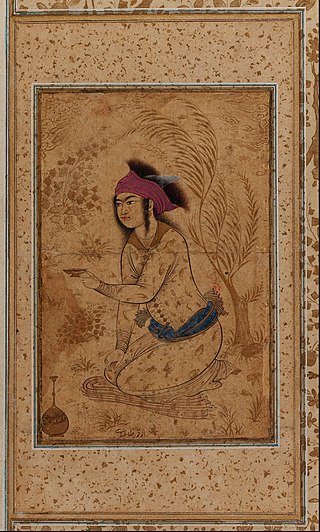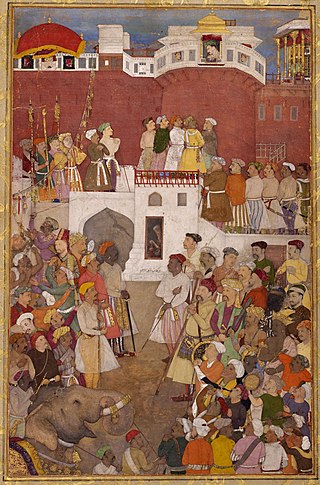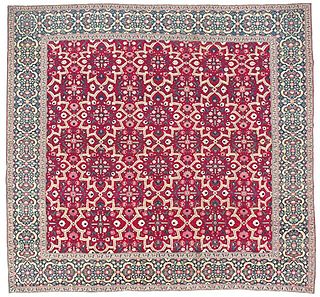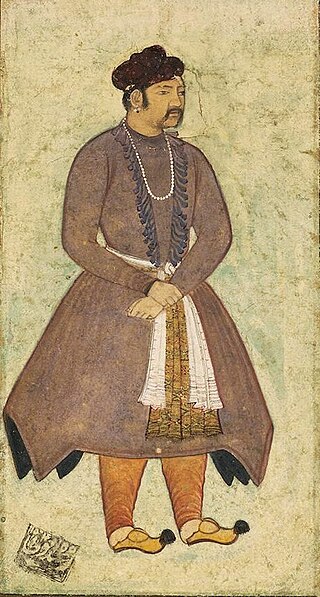
Nur-ud-Din Muhammad Salim, known by his imperial name Jahangir, was the fourth Mughal Emperor, who ruled from 1605 till his death in 1627.

Mirza Shahab-ud-Din Muhammad Khurram, also known as Shah Jahan I, was the fifth Mughal emperor, reigning from 1628 until 1658. During his reign, the Mughals reached the peak of their architectural and cultural achievements.

Mumtaz Mahal was the empress consort of Mughal Empire from 1628 to 1631 as the chief consort of the fifth Mughal emperor, Shah Jahan. The Taj Mahal in Agra, often cited as one of the Wonders of the World, was commissioned by her husband to act as her tomb.

Mughal painting is a South Asian style of painting on paper confined to miniatures either as book illustrations or as single works to be kept in albums (muraqqa), originating from the territory of the Mughal Empire in the Indian subcontinent. It emerged from Persian miniature painting and developed in the court of the Mughal Empire of the 16th to 18th centuries. Battles, legendary stories, hunting scenes, wildlife, royal life, mythology, as well as other subjects have all been frequently depicted in paintings.

Anarkali is a legendary lady said to be loved by the 16th-century Mughal Prince Salim, who later became Emperor Jahangir. According to some accounts, Anarkali was the nickname of the tawaif Sharf-un-Nisa, though scholars hold varying opinions.

The Mughal dynasty was a Muslim empire, which comprised the members of the imperial House of Babur (Persian: خاندانِ آلِ بابُر; Khāndān-e-Āl-e-Bābur), also known as the Gurkanis, who ruled the Mughal Empire from c. 1526 to 1857.

Abu'l-Hasan, from Delhi, India, was a Mughal painter of miniatures during the reign of Jahangir.

A Muraqqa is an album in book form containing Islamic miniature paintings and specimens of Islamic calligraphy, normally from several different sources, and perhaps other matter. The album was popular among collectors in the Islamic world, and by the later 16th century became the predominant format for miniature painting in the Persian Safavid, Mughal and Ottoman empires, greatly affecting the direction taken by the painting traditions of the Persian miniature, Ottoman miniature and Mughal miniature. The album largely replaced the full-scale illustrated manuscript of classics of Persian poetry, which had been the typical vehicle for the finest miniature painters up to that time. The great cost and delay of commissioning a top-quality example of such a work essentially restricted them to the ruler and a handful of other great figures, who usually had to maintain a whole workshop of calligraphers, artists and other craftsmen, with a librarian to manage the whole process.

The Mughal Empire was an early modern empire in South Asia. At its peak, the empire stretched from the outer fringes of the Indus River Basin in the west, northern Afghanistan in the northwest, and Kashmir in the north, to the highlands of present-day Assam and Bangladesh in the east, and the uplands of the Deccan Plateau in South India.

Manavati Bai, also spelled Manvati Bai,, better known by her title, Jagat Gosain, was the second wife and the empress consort of the fourth Mughal emperor Jahangir and the mother of his successor, Shah Jahan.

Jharokha Darshan was a daily practice of addressing the public audience (darshan) at the balcony (jharokha) at the forts and palaces of medieval kings in India. It was an essential and direct way of communicating face-to-face with the public, and was a practice which was adopted by the Mughal emperors. The balcony appearance in the name of Jharokha Darshan also spelled jharokha-i darshan was adopted by the 16th-century Mughal Emperor Akbar, even though it was contrary to Islamic injunctions. Earlier, Akbar's father Emperor Humayun had also adopted this Hindu practice of appearing before his subjects at the jharokha to hear their public grievances.

History of clothing in the Indian subcontinent can be traced to the Indus Valley civilization or earlier. Indians have mainly worn clothing made up of locally grown cotton. India was one of the first places where cotton was cultivated and used even as early as 2500 BCE during the Harappan era. The remnants of the ancient Indian clothing can be found in the figurines discovered from the sites near the Indus Valley civilisation, the rock-cut sculptures, the cave paintings, and human art forms found in temples and monuments. These scriptures view the figures of human wearing clothes which can be wrapped around the body. Taking the instances of the sari to that of turban and the dhoti, the traditional Indian wears were mostly tied around the body in various ways.
Siyaasat is a 2014 Indian fictional drama which aired on The EPIC Channel. The series is an adaptation of the popular 2002 award-winning fictional novel The Twentieth Wife by author Indu Sundaresan.

Mughal clothing refers to clothing worn by the Mughals in the 16th, 17th and 18th centuries throughout the extent of their empire. Much of them were already being used in the past centuries before their arrival in Indian subcontinent. It was characterized by luxurious styles and was made with muslin, silk, velvet and brocade. Elaborate patterns including dots, checks, and waves were used with colors from various dyes including cochineal, sulfate of iron, sulfate of copper, and sulfate of antimony were used.

The term jama refers to a long coat which was popular in South Asia during the early modern era.

Mughal carpets were the handwoven floor coverings used in the Mughal Empire in their courts. Mughal carpets and rugs have their roots in India since the 16th and 17th centuries. Mughal carpets were a blend of Persian and Indian artistry uniquely designed with scenic landscapes, floral, and animal patterns. Kashmir was producing the finest wool and silk carpets and rugs, including prayer rugs. Sometimes the knot density in these rugs was so fine and tight as 300 knots per square centimeter.

Katzeb was an article of dress encircling the body, at the waist with ends hanging in the front. It was a kind of sash also called patka.

A qaba is a long coat with sleeves and buttons, similar to a cassock, open at the front. A qaba is similar to a wadded coat. It is considered of Turkic origin.
Chiltah was a Mughal period outer garment. It resembled a quilted coat. Chiltah was a royal garment. Jahangir, the fourth Mughal Emperor, wore a nadiri garment with a chiltah.


















